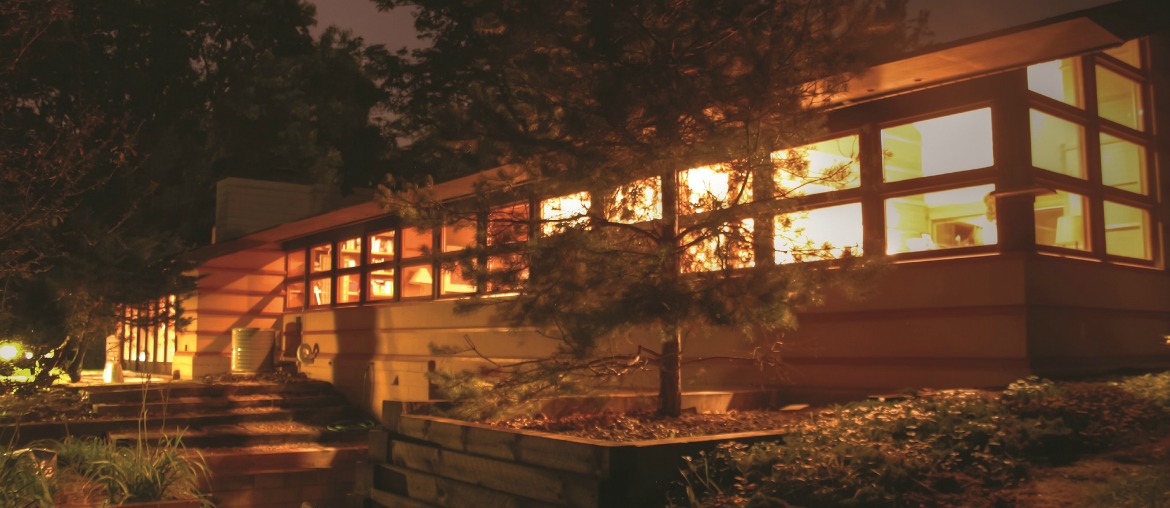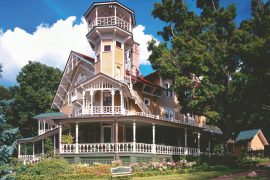It is hard to think of Frank Lloyd Wright without also thinking of Wisconsin, and it is equally hard to think of Wisconsin without thinking of Frank Lloyd Wright. The Madison area especially reflects a longtime love affair (with all the drama, and often discord you’d expect from any fine romance) between a man and a city, a city and a man.
The soaring roof of the Unitarian Meeting house, Wright’s iconic contribution to Madison’s west side. Taliesin, his ever evolving living workshop built into the hills of Spring Green. Monona Terrace, a landscape-changing lakeside convention center brought to life years after the famed architect’s death.
And most of us don’t have to reach too deep into our brains to think of another of his major contributions to the architecture pantheon: the spiraling Solomon R. Guggenheim Museum, with its ramped modern art galleries and ethereal central skylight in New York City; Fallingwater, the rural Pennsylvania landmark home cantilevered over a waterfall; and the series of stately residences scattered throughout Oak Park, Ill., Chicago and other nearby suburbs.
Yet we hold Wright, who was born in Richland Center (located about an hour west of Madison) and spent much of his childhood in and near Madison, particularly dear in these parts. his indelible touch shaped not only the built environment in central Wisconsin but also the architectural sensibilities of its residents, many of whom still favor the horizontal lines of Prairie Style that Wright championed in the early part of the 20th century.
But it isn’t just a church, convention center and an aura that remains. For decades Wright worked as a prolific architect, moving easily from residential to commercial work and back again. Hundreds of his buildings, including several private residents in Madison, still stand. While not open to the public, they hide in plain sight with varying degrees of visibility from city streets and sidewalks. Take a drive or a walk to witness a few for yourself.
Lamp House, 1903 (22 N. Butler St., Madison)
Situated in the middle of the block on Madison’s narrow isthmus, the Robert M. Lamp House is an early example of Wright’s residential architecture. The boxy cream brick home predates both Wright’s ubiquitous Prairie-style designs with their strong horizontal lines and his more aspirational and economical Usonian homes with their compact floor plans and extensive use of natural materials. The Lamp House has invited controversy over the years, as local preservationists have fought redevelopment on the street. The owner, a developer himself, currently rents the building and has not publicly expressed concern over the reclamation infill projects and redevelopment in the neighborhood. Set far back on a narrow lot in a built-up neighborhood, the Lamp House is visible from the street, but you’ll have to crane your neck.
Airplane House, 1908 (120 Ely Lane, Madison)
The Eugene A. Gilmore house, more commonly known as “The Airplane House” is a classic example of Wright’s Prairie style. The large home was designed for University of Wisconsin law professor Eugene Gilmore. Look for the prow, which Wright also incorporated into Oak Park’s famed Robie House, which lends the house its nickname.
Jacobs First House, 1937 (441 Toepfer St. Madison)
Widely regarded as the first Usonian home, the Herbert and Katherine Jacobs First House is a modest ranch on Madison’s west side. Reportedly built for $5,500, including the architect fee, the home was the first of many of Wright’s experiments with both spatial and cost economies that eventually included built-in furniture, reclaimed materials and prefabrication.
Pew House, 1938-1940 (3650 Lake Mendota Drive, Madison)
Known colloquially as the “poor-man’s Fallingwater,” the John C. Pew house is a classic example of Wright’s Usonian ambition. Set on a narrow and steep lot, and cantilevered over a ravine instead of a waterfall (as is Fallingwater, which Wright is rumored to have called “a rich-man’s Pew House” when the comparison was made to him), the structure is textbook Wright with strong horizontal lines, cypress interiors and in-floor radiant heat. The home, changing owners for only the second time, sold in 2006 for $1.5 million.
Jacobs Second House, 1946-1948 (3995 Shawn Trail, Middleton)
Unique among his designs, Wright’s semicircular house was an early experiment with passive heating and cooling. Wright had the northern façade built into the earth as a windbreak, and he crafted a bank of windows facing south toward a sunken garden to bring in warmth and light. The house used in-floor radiant heat with iron pipes set in gravel beneath the lower-level concrete floor, although the National Register of Historic Places registration form indicates that the owner later added a radiator to the second-floor bathroom and subsequent owners completely modernized the heating system.
History suggests that a dispute between Wright — widely assumed to have been contentious with customers — and his client, Herbert Jacobs, caused a rift during the bulk of construction. This left Jacobs to oversee the completion of the home without assistance from Wright.
Van Tamelen House, 1956 (5817 Anchorage Road, Middleton)
Set back from the circle and largely obscured by the landscaping and topography, the Eugene Van Tamelen house provides a peek into Wright’s dream to bring affordable design to the masses. Wright collaborated with Marshall Erdman & Associates, a local design and construction firm, to create three sets of plans for prefabricated Usonian homes. Customers received their kits after submitting topographic maps of lots to Wright, who, showing his tendency to control details normally left to clients, would select the site for the home. the Prefab no. 1 single-story, l-shaped Van Tamelen House was the first of the Erdman Prefabs to be built.
Rudin House, 1957 (110 Marinette Trail, Madison)
The Walter Rudin House is the first of only two completed Erdman Prefab no. 2 designs. Constructed of concrete block, the home’s signature feature is the two-story living room with stunning walls of windows.
This article originally appeared in the 2015 fall/winter issue of Experience Wisconsin magazine. The contents of this article were checked for accuracy when it was published; however, it’s possible some of the information has changed. We recommend you call first if you have specific questions for the destinations, attractions or restaurants mentioned in this article.
No portion of this article or magazine may be reproduced without prior written permission by the publisher.






1 Comment
Pingback: A Weekend in Spring Green - Experience Wisconsin